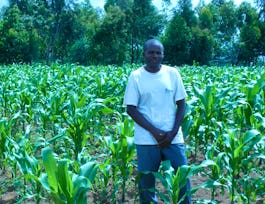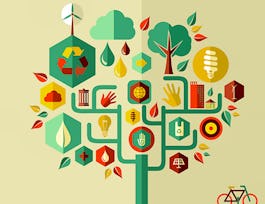Environmental economics is a powerful and comprehensive approach to understanding, assessing, and addressing the world’s most pressing environmental and sustainability challenges. This course, “Environmental Economics,” provides training in the principles, conceptual frameworks, and applications of environmental economics.



Environmental Economics
This course is part of Green Skills for a Sustainable and Just Future Specialization

Instructor: Michael Moore
Sponsored by Coursera Learning Team
Recommended experience
What you'll learn
Understand key concepts like market failures and externalities in relation to the environment
Learn how environmental economics is used to create and evaluate sustainability policies
Explore methods of valuing environmental goods and services that are not typically sold in markets
Learn economic approaches to assessing the global transition to renewable energy and climate policies aimed at limiting global temperature increases
Skills you'll gain
Details to know

Add to your LinkedIn profile
19 assignments
December 2024
See how employees at top companies are mastering in-demand skills

Build your subject-matter expertise
- Learn new concepts from industry experts
- Gain a foundational understanding of a subject or tool
- Develop job-relevant skills with hands-on projects
- Earn a shareable career certificate


Earn a career certificate
Add this credential to your LinkedIn profile, resume, or CV
Share it on social media and in your performance review

There are 7 modules in this course
Pollution externalities are widespread in modern industrial economies. In microeconomics, an externality is a key defect of a market and creates the rationale for government intervention in the economy. This first module provides an overview of the field of Environmental Economics and reviews the essential microeconomic principles for the course.
What's included
6 videos5 readings2 assignments1 discussion prompt
Concepts and methods are needed for quantifying the economic value of goods and services not transacted in markets. “Nature’s services” are a prime example of these. These methods, and their application, are an important sub-field of environmental economics, with relevance to public policy and government programs.
What's included
5 videos2 readings3 assignments
Environmental regulation typically involves a public policy that requires companies to reduce emissions of one or more pollutants. Market-based policy instruments are defined by providing financial incentives for companies to reduce emissions, instead of prescribing particular reductions. They have the virtue of cost-effectiveness, that is, of achieving least-cost compliance with the regulation. This module uses the example of carbon dioxide (CO2) emissions as the regulated pollutant.
What's included
7 videos1 reading3 assignments
The economic benefits and/or costs of a prospective policy or program can occur at different times in the future. Discounting is an approach for translating future dollar values into a consistent metric, present-value dollars. Discounting plays an important role in quantifying the Social Cost of Carbon – a key concept in the economics of climate policy. The material in this module builds a bridge to the next module on benefit-cost analysis.
What's included
4 videos1 reading2 assignments
Benefit-cost analysis (abbreviated as BCA) is the standard economic framework for evaluating a public policy or government program. It involves enumerating the various categories of benefits and costs of a policy and, where possible, quantitatively estimating those benefits and costs. An example is provided of the BCA conducted for the first major climate policy in the United States: greenhouse gas emissions standards for automobiles, which was finalized in 2012.
What's included
4 videos2 readings3 assignments
Transitioning from fossil fuel to renewable energy resources is a critical issue of global sustainability. This transition is inherently an intertemporal problem: the global economy depletes the physical stock of fossil fuel over time before transitioning to renewable resources such as solar and wind. We develop the conceptual framework used in economics to understand the problem. An empirical application of the framework demonstrates the key economic logic: the economy transitions to renewable energy when renewables are cost-competitive with fossil fuel.
What's included
5 videos1 reading3 assignments
The amount of carbon dioxide in Earth’s atmosphere is a second resource stock (in reference to Module 6’s stock of fossil fuel). The carbon budget is a common way to express this stock: beginning now, how much carbon dioxide can be emitted into the atmosphere before a particular climate policy target is reached? We build on the conceptual framework of Module 6 to consider a carbon budget as an expression of global climate policy. We then consider a benefit-cost analytic approach to assessing climate policy options. We understand both elements of, and results from, the analysis.
What's included
5 videos2 readings3 assignments
Instructor

Offered by
Why people choose Coursera for their career




Recommended if you're interested in Social Sciences

University of Western Australia

Duke University

University of Colorado Boulder

Open new doors with Coursera Plus
Unlimited access to 10,000+ world-class courses, hands-on projects, and job-ready certificate programs - all included in your subscription
Advance your career with an online degree
Earn a degree from world-class universities - 100% online
Join over 3,400 global companies that choose Coursera for Business
Upskill your employees to excel in the digital economy



